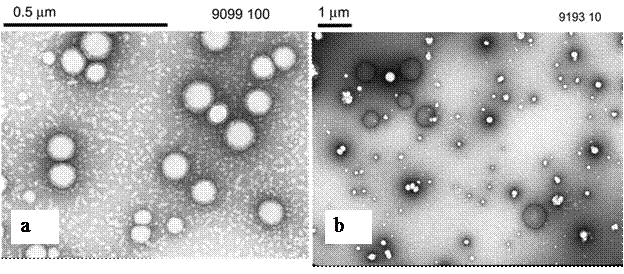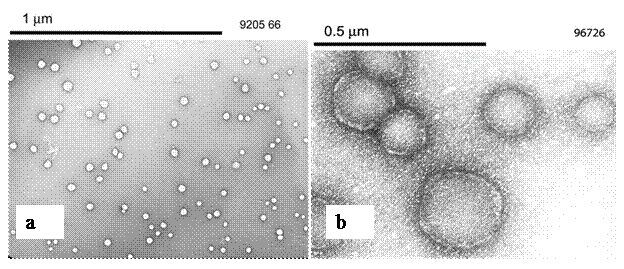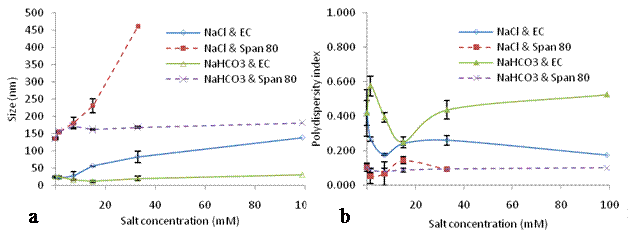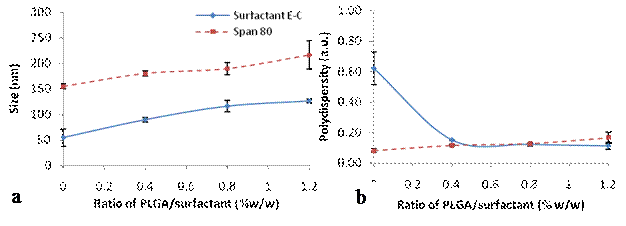Reports: GB7
44507-GB7 Design of Biodegradable Surfactants to Control and Manipulate Physical Properties of Polymeric Nanoparticles Made by Emulsion Evaporation Method
Main accomplishments
The ultimate goal of the present research is to design bio-friendly surfactants (BFS), derivatives of alpha-tocopherol, to be used in the synthesis of biocompatible and biodegradable nanoparticles of controlled physical properties (size, morphology).
More specifically, the following objectives were proposed:
- To synthesize bio-friendly surfactants by covalently linking ascorbic acid to alpha-tocopherol derivatives
- To synthesize PLGA nanoparticles using the emulsion-evaporation method in the presence of the new, bio-friendly surfactants.
- To characterize the PLGA nanoparticles in terms of size, size distribution, morphology, and toxicity.
Of the three objectives, objective 1 was met during 2006-2007, as anticipated. A bio-friendly surfactant was synthesized from alpha-tocopherol, ascorbic acid, and maleic anhydride and the solubility, surface tension in water, and antioxidant activity of the surfactant were determined. The synthesis of the biofriendly surfactant (BFS) was continued in 2007-2008, with the goal of finding the appropriate conditions under which this new compound could aid in formation of nanoparticles (Objectives 2 and 3 of the grant). During 2007-2009, objectives 2 and 3 were thoroughly met.
Bio-friendly surfactant (BFS) synthesis (Objective 1)
The BFS was made from ascorbic acid and alpha-tocopherol following the synthetic pathway shown below. The final structure was confirmed by C-NMR.
|
Nanoparticle synthesis and characterization (Objectives 2 and 3)
Self-assembled bio-friendly (BFS) nanostructures and PLGA-BFS nanoparticles were made by nanoprecipitation. Physical properties (size, size distribution, morphology) of the nanostructures were studied at different salt concentrations, surfactant concentrations, and polymer:surfactant ratios. Span 80 was selected as a control due to its similar surfactant properties (MW, hydrophobicity) to the BFS. The newly synthesized BFS surfactant was shown to form self-assembled nanostructures (Figure 1a) of 22 to 137.8 nm in diameter in the presence of sodium chloride, or measuring 11.6 to 30.9 nm when synthesis was carried out in sodium bicarbonate (Figure 2a). The polydispersity index (0.267 to 0.175) was smaller for particles made in NaCl as compared to values of 0.575 to 0.524 for the same concentration range in sodium bicarbonate (Figure 2b). Span 80 formed monodisperse vesicles (Figure 1b) of bigger size, measuring 136 to 460 nm (Figure 2).
Synthesis of polymeric nanoparticles was successfully accomplished by adding the hydrophobic polymer PLGA, and using BFS or Span 80 as surfactants in 15 mM sodium bicarbonate (Figure 3). Polymeric PLGA-BFS nanoparticles presented a size of 89.6 to 126.2 nm for 40% to 120% mass ratio PLGA to surfactant (Figure 4a). For the same mass ratios, the PLGA-Span 80 formed particles measured 154.8 to 216 nm (Figure 4a). The polydispersity for polymeric samples with BFS or Span80 was similar with values ranging from 0.113 to 0.165 (Figure 4b). Span 80 surfactant formed bilayers, whereas BFS formed monolayers at the interfaces, which explains the smaller size of the PLGA-BFS nanostructures.
The polymeric PLGA-EC nanoparticles showed an antioxidant activity (IC50 of 36.3 to 42.1 mM as measured by DPPH assay). The capacity to provide antioxidant action was provided by the vitamin C moiety of the EC surfactant which localized at the interface between the PLGA hydrophobic core and water. In comparison, the PLGA-span80 particles did not show any antioxidant activity.
It can be concluded that the newly synthesized BFS surfactant was successful in forming uniform, small size polymeric nanoparticles of intrinsic antioxidant properties, which was the overall goal of this project.
Figure 1: TEM of a. BFS and b. Span 80 self-assembled nanostructures
Figure 2: Effect of salt concentration on the a. size and b. polydispersity of self-assembled Span 80 and BFS nanostructures.
 Figure 3: TEM pictures
of a. PLGA-BFS and b. PLGA-Span80 nanostructures
Figure 3: TEM pictures
of a. PLGA-BFS and b. PLGA-Span80 nanostructures
Figure 4. a. Size and b. polydispersity of polymeric PLGA nanoparticles synthesized with BFS and Span80.
Future plans
The goal is to continue the research developed with support from ACS-PRF; new surfactants will be made from other naturally occurring antioxidants, and MD simulations (in collaboration with Southestern Louisiana University) will be performed to understand the self-assembly process of these new biofriendly surfactants. A grant proposal will be submitted to ACS-PRF to support this work.
Impact of PRF-G funding on the PI's professional development
Funding from ACS PRF-G was instrumental in the development of the PI's program. Supplies, stipends for undergraduate and graduate students were made possible from this award. While a proposal on synthesis of novel biofriendly surfactants for use in the preparation of polymeric nanoparticles was not successfully funded by the NSF Chemistry division, novel ideas were generated and preliminary data was acquired during the duration of the PRF-G proposal which will be vitally needed for future grant submissions. A grant proposal on Vitamin E delivery was funded by USDA in 2008 and part of its success can be attributed to ACS support. Also, most importantly, a cohesive research team was created as a result of working on this grant (Dr. Dolliver-chemist, Dr. Norwood-physicist, Dr. Nesterov-chemist, and Dr. Sabliov-biological engineer) and the strong relationships developed during the last three years will surely help the PI's future professional development, as well as contribute to other team members' success.










